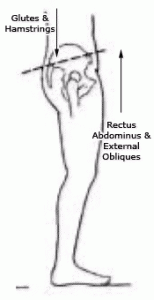By Parker Swiggart
You see people day in and day out working hard in the gym when they could be improving at a much faster rate. This is because your body is trying to protect you, against yourself! Your poor posture is causing many aches and pains yet you don’t know it, so you don’t know to correct it. What if we trained in a way that allowed us to work on our postures and correct our muscle imbalances and tight joints so that you improve your posture? There are many things that effect posture, but in this blog, we will focus on the pelvis. The goal of this post is to increase your awareness of your pelvic alignment so you can find exercises to improve it.
In the first picture we have someone with optimal pelvic alignment. There is a neutral pelvis when there is a slight curve of the lower back and you do not experience a tight lower back and/or tight quadriceps muscles. When someone is in optimal alignment, it is likely that the rest of the body is in good shape, with little chance of injury.
In the second picture is someone in anterior pelvic tilt. This flawed position is the most common. When the body is in anterior pelvic tilt, you have someone that has tight hip flexors and spinal erectors and weak abdominals and gluteal. So to train in a way to correct the imbalances, you need to stretch the muscles that perform hip flexion such as the rectus femoris, tensor fasciae latae, and iliacus, these are muscles of the quadriceps. Along with these stretches’ you need to strengthen the abdominals, gluteal, and hamstrings.
The third picture is someone in posterior pelvic tilt. This is less common but can be more serious due to increased risk of herniating a disk. The lumbar curve in the lower back flattens out causing the upper back to round forward, which can cause cervical disc herniations as well. Just like the anterior pelvic tilt we have muscles that we need to strengthen and ones we need to stretch. For posterior pelvic tilt, we need to stretch the abdominals, gluteals, and hamstrings. We also need to strengthen the rectus femoris, tensor fasciae latea, iliacus, and spinal erectors.
So whether you are in anterior pelvic tilt or posterior pelvic tilt use your time at the gym to help correct these imbalances and not make them worse.
“Hips Don’t Lie – Robertson Training Systems.” Robertson Training Systems. N.p., n.d. Web. 01 Oct. 2014.


